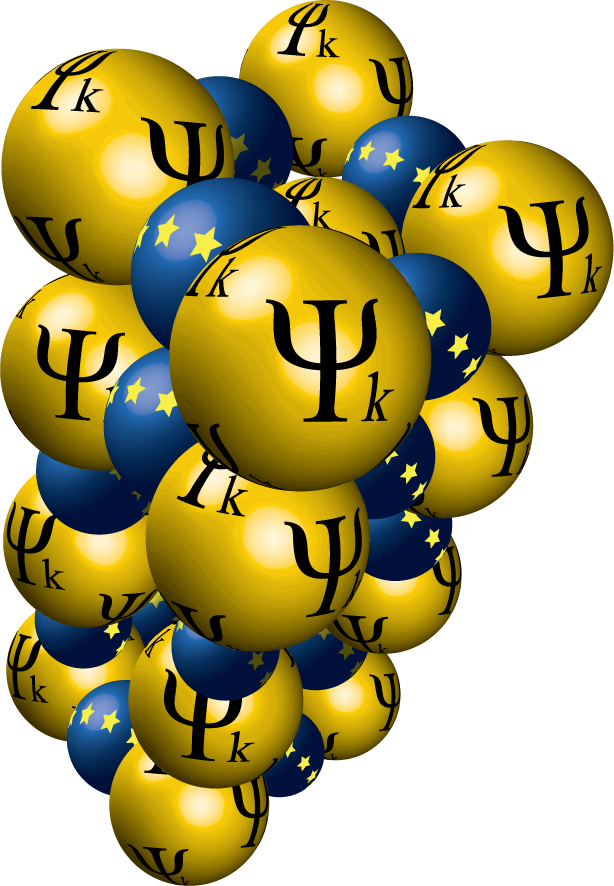Spin-Orbit Entangled Quantum Magnetism
The workshop is also supported by the Psi-k Network  and VASP
and VASP  .
.
Understanding the phenomenon of solid-state magnetism and devising its technological applications have been one of the main goals of condensed matter physics since its apparition [1]. In the second half of the twentieth century, the main focus of this field was in general on the first row of the transition metals (TM) and their compounds. The elemental iron, cobalt and nickel - which are prototypical itinerant ferromagnetic metals – were intensively investigated. The magnetism of correlated insulators embodied by 3d TM oxides attracted no less attention; its principal mechanisms – double exchange and superexchange, Jahn-Teller interaction, orbital orders – were uncovered and their mutual interaction explored [2,3].
In the first two decades of the XXI century, research in solid-state magnetism is progressively shifting towards the exciting and much less understood domain of spin-orbit magnetism [4,5]. The materials hosting heavy d and f ions exhibit a multitude of unusual quantum states – multipolar orders, quantum spin and dimer-bond liquids, spin-orbit excitons, topological phases, fractional excitations – that defy the conventional paradigm of distinct spin and orbital degrees of freedom possessing different characteristic energy scales and symmetries. The large spin-orbit interaction due to heavy nuclei of those ions couples the corresponding on-site moments leading to an emergence of spin-orbital-entangled ionic ground state. This spin-orbit entanglement is at the origin of phenomena cited above. Their rich physics arising due to intersite coupling between single-ion spin-orbit entangled states, their interaction with lattice degrees of freedom [5], applied field and external perturbations has stimulated vast research activity in this area as documented by several prominent review papers [6,7,8].
Progress in the field of spin-orbit magnetism is driven, first of all, by the ever increasing ability to synthesize high-purity materials, both in their bulk [9,10,11,12] and, more recently, in virtually perfect 2D form [13,14]. The organizers of this workshop have contributed to this emerging field by disclosing multipolar phases in correlated f electron systems [15,16,17] and 5d oxides [18,19], have developed advanced numerical techniques [20,21] and revealed the formation of spin-orbit symmetry-broken phases in 5d double perovskites [22,23]. Exotic quantum states in these materials emerge at rather low temperatures of several tens of Kelvins. Their detection and characterization represent a significant challenge to experiment. Conventional probes of the ordered magnetism, like the neutron diffraction, are often insensitive to high-rank multipolar moments that may have too small form-factors or generate no magnetic density at all. Hence, an array of alternative spectroscopic techniques like the resonant and non-resonant inelastic X-ray scattering, nuclear magnetic resonance, muon and Raman spectroscopies has been applied to resolve the nature of unconventional order parameters in spin-orbit materials [24,25,26].
Theory of spin-orbital magnetism has been developed along two virtually independent directions. The first route is based on semi-empirical tight-binding schemes of a target class of materials, from which one derives many-body effective Hamiltonians (MBEH) involving only the degrees of freedom that are relevant for low-energy (low-temperature) physics. Such Hamiltonians are subsequently solved by analytical or numerical many-body techniques. The emphasis is thus on the description of the low-energy many-body states and their responses. The second route employs ab initio density-functional theory (DFT) methods, fully taking into account the electronic structure of a given material. The low-energy physics emergent from the electronic structure is, in contrast, treated in a highly simplified way. Recently, an ab initio approach [26,27] merging DFT with dynamical mean-field theory (DMFT) [29,30] has been extensively applied to calculate electronic structure of spin-orbit materials [31], but due to high computational cost of treating low-temperature ordered phases its application to exotic orders in spin-orbit materials is still limited [32]. The focus of DFT(+DMFT) studies is thus usually on electronic high-energy properties and total energy of local-moment phases. Both the MBEH and DFT approaches have had some impressive successes [6,33,34] but the synergy between them remains underdeveloped [21].
Overall goal: It is the goal of this workshop to assemble both leading experts and younger researches on spin-orbit entangled magnetism from different domains – theoreticians of both DFT and MBEH leaning as well as experimentalists – to review the current progress in the field and, most importantly, to foster the mutual collaboration and synergy between theory and experiments to address and define actual challenges and future research directions. Focus session on: double perovskites, pyrochlores, Kitaev/honeycomb, candidate spin-liquid materials, multiferroics, 2D magnetism.
Applications
There is no registration fee. Maximum number of participants: 60
There will be a poster session and a few contributed talks to which the participants are encouraged to contribute. Applications to participate can be made by sending an email to
magnetism2024@univie.ac.at
providing the following information:
First Name, Last Name:
Affiliation:
Career stage:
Motivation:
Topic of presentation:
Type of presentation (poster or contributed):
Registration deadline: June 1, 2024
References
[1] Magnetism and Magnetic Materials, J. M. D. Coey, Cambridge University Press (2012).
[2] Simple Models of Magnetism, R. Skomski, Oxford University Press (2008).
[3] Transition Metal Compounds, D. I. Khomskii, Cambridge University Press (2014).
[4] P. Santini, S. Carretta, G. Amoretti, R. Caciuffo, N. Magnani, and G. H. Lander, Rev. Mod. Phys. 81, 807 (2009).
[5] Sergey V. Streltsov and Daniel I. Khomskii Phys. Rev. X 10, 031043
[6] G. Jackeli and G. Khaliullin, Phys. Rev. Lett. 102, 017205 (2009).
[7] W. Witczak-Krempa, G. Chen, Y. B. Kim, and L. Balents, Annu. Rev. Condens. Matter Phys. 5, 57 (2014).
[8] T. Takayama, J. Chaloupka, A. Smerald, G. Khaliullin, and H. Takagi, J. Phys. Soc. Jpn. 90, 062001 (2021).
[9] D. D. Maharaj, et al. Phys. Rev. Lett. 124, 087206 (2020).
[10] Liang Fu Phys. Rev. Lett. 115, 026401 (2015)
[11] G. Khaliullin, D. Churchill, P. P. Stavropoulos, and H.-Y. Kee, Phys. Rev. Research 3, 033163 (2021).
[12] A. Takahashi and H. Shiba, J. Phys. Soc. Jpn. 69, 3328 (2000).
[13] Huang, B. et al. Nature 546, 270–273 (2017).
[14] Soriano, D. et al. Nano Letters 20, 6225–6234 (2020).
[15] Leonid V. Pourovskii and Sergii Khmelevskyi, PNAS 118 (14) e2025317118 (2021)
[16] L. V. Pourovskii, S Khmelevskyi, Phys. Rev. B 99 (9), 094439 (2019).
[17] SL Dudarev, P Liu, DA Andersson, CR Stanek, T Ozaki, C Franchini, Phys Rev. Materials 3 (8), 083802 (2019).
[18] Dario Fiore MOsca et al., Phys. Rev. B 103, 104401 (2021).
[19] L. V. Pourovskii, D. F. Mosca, and C. Franchini Phys. Rev. Lett. 127, 237201 (2021).
[20] L. V. Pourovskii, Phys. Rev. B 94, 115117 (2016).
[21] DF Mosca, LV Pourovskii, C Franchini Physical Review B 106 (3), 035127 (2022).
[22] L Lu, M Song, W Liu, AP Reyes, P Kuhns, HO Lee, IR Fisher, VF Mitrović
Nature comm. 8, 14407.
[23] VFM W. Liu, R. Cong, A. P. Reyes, I. R. Fisher Phys. Rev. B 97, 224103.
[24] P. Santini et al. Phys. Rev. Lett. 97, 207203 (2006).
[25] H.-H. Kung et al. Science 347, 1339 (2015).
[26] D. D. Maharaj et al. Phys. Rev. Lett. 124, 087206 (2020).
[27] V. I. Anisimov et al. Journal of Physics: Condensed Matter 9, 7359 (1997).
[28] A. I. Lichtenstein and M. I. Katsnelson, Phys. Rev. B 57, 6884 (1998).
[29] W. Metzner and D. Vollhardt, Phys. Rev. Lett., 62, 324 (1989).
[30] A. Georges and G. Kotliar, Phys. Rev. B, 45, 6479–6483 (1992).
[31] K. Haule and G. Kotliar, Nature Physics 5, 796 (2009).
[32] C Martins, M Aichhorn, and S Biermann, J. Phys.: Condens. Matter 29 263001 (2017).
[33] B. J. Kim et al. Phys. Rev. Lett.101, 076402 (2008).
[34] G. Chen, R. Pereira, and L. Balents, Phys. Rev. B 82, 174440 (2010).
Coming soon.
Organizers
| Name | Affiliation |
|---|---|
| Cesare Franchini | University of Vienna |
| Vesna Mitrovic | Brown University |
| Leonid Pourovskii | Ecole Polytechnique, Palaiseau |
Attendees
| Name | Affiliation |
|---|---|
| Sergey Artyukhin | Italian Institute of Technology, Genova |
| Jakob Baumsteiger | University of Bologna |
| Srishti Bhardwaj | Indian Institute of Technology, Roorkee |
| Silke Biermann | Ecole Polytechnique, Palaiseau |
| Piotr Błoński | Palacký University Olomouc, Regional Centre of Advanced Technologies and Materials, Czech Advanced Technology and Research Institute (CATRIN) |
| Stefan Bluegel | Forschungszentrum Jülich |
| MATTEO BRIGANTI | University of Florence |
| Johanna Paulina Carbone | Technical University of Vienna |
| Lorenzo Celiberti | University of Vienna |
| Liviu Chibotaru | KU Leuven |
| Matteo Costa | University of Bologna |
| Diana Csontosova | Masaryk University |
| Maria Daghofer | University of Stuttgart |
| BERNARD DONFACK | University of Dschang |
| Claude Ederer | ETH Zurich |
| Olle Eriksson | Uppsala University |
| Dario Fiore Mosca | École Polytechnique, Palaiseau, University of Vienna |
| Ellen Fogh | EPFL, Lausanne |
| Bruce Gaulin | McMaster University |
| Marco Gibertini | University of Modena and Reggio Emilia |
| Daigorou Hirai | Nagoya University |
| Marie Therese Huebsch | VASP GmbH |
| Naoya Iwahara | Chiba University |
| Darin Joseph | University of Bologna |
| Mikhail Katsnelson | Radboud University |
| Hae-Young Kee | University of Toronto |
| Giniyat Khaliullin | Max Planck Institute for Solid State Research |
| Sergii Khmelevskyi | Technical University of Vienna |
| Bongjae Kim | Kyungpook National University |
| Jungho Kim | Argonne National Laboratory |
| Yong Baek Kim | University of Toronto |
| Ramesh Kumar | Delhi Technological University |
| Marjana Lezaic | Forschungszentrum Jülich |
| Dongzhe Li | University of Toulouse |
| Xinwei Li | National University of Singapore |
| Francesco Martinelli | ETH Zurich |
| Marco Moretti | Politecnico di Milano |
| Alberto Morpurgo | Universite de Geneve |
| Toshihiko Muroi | University of Tokyo |
| Branislav Nikolic | University of Delaware |
| Thomas Olsen | Technical University of Denmark |
| Federico Orlando | Politecnico di Milano |
| Arun Paramekanti | University of Toronto |
| Eva Pavarini | Forschungszentrum Jülich |
| Silvia Picozzi | CNR-SPIN |
| Stefano Pittalis | Istituto Nanoscienze, Consiglio Nazionale delle Ricerche |
| Kemp Plumb | Brown University |
| Jeffrey Quilliam | Université de Sherbrooke |
| Rashmi Ranjan Routaray | Université Catholique Louvain |
| Samuele Sanna | University of Bologna |
| DD Sarma | Indian Institute of Science |
| Nicola Spaldin | ETH Zurich |
| Sergey Streltsov | - |
| Nandini Trived | Ohio State University |
| Ilja Turek | Czech Academy of Sciences, Institute of Physics of Materials |
| Payal Wadhwa | University of Vienna |
| Ivica Zivkovic | EPFL, Lausanne |
- Type:
- Workshop
- When:
- Sept. 23, 2024 — Sept. 27, 2024
- Where:
- ESI Boltzmann Lecture Hall
- Organizer(s):
-
Cesare Franchini (U of Vienna)
Vesna Mitrovic (Brown U, Providence)
Leonid Pourovskii (École Polytechnique, Palaiseau)